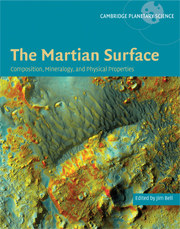Book contents
- Frontmatter
- Contents
- List of contributors
- Foreword
- Acknowledgments
- Part I Introduction and historical perspective
- Part II Elemental Composition: Orbital and in situ Surface Measurements
- Part III Mineralogy and Remote Sensing of Rocks, Soil, Dust, and Ices
- Part IV Physical Properties of Surface Materials
- 18 The thermal inertia of the surface of Mars
- 19 Physical properties of the Martian surface from spectrophotometric observations
- 20 In situ observations of the physical properties of the Martian surface
- 21 Martian surface properties from joint analysis of orbital, Earth-based, and surface observations
- Part V Synthesis
- Part VI Summary, Upcoming Missions, and New Measurement Needs
- Index
- Plate section
- References
20 - In situ observations of the physical properties of the Martian surface
from Part IV - Physical Properties of Surface Materials
Published online by Cambridge University Press: 10 December 2009
- Frontmatter
- Contents
- List of contributors
- Foreword
- Acknowledgments
- Part I Introduction and historical perspective
- Part II Elemental Composition: Orbital and in situ Surface Measurements
- Part III Mineralogy and Remote Sensing of Rocks, Soil, Dust, and Ices
- Part IV Physical Properties of Surface Materials
- 18 The thermal inertia of the surface of Mars
- 19 Physical properties of the Martian surface from spectrophotometric observations
- 20 In situ observations of the physical properties of the Martian surface
- 21 Martian surface properties from joint analysis of orbital, Earth-based, and surface observations
- Part V Synthesis
- Part VI Summary, Upcoming Missions, and New Measurement Needs
- Index
- Plate section
- References
Summary
ABSTRACT
The physical properties of rocks and soils on the surface of Mars have been investigated by several landed spacecraft. Studies of these physical properties constrain interpretation of Martian geologic processes and provide engineering data for future mission planning. As on Earth, these properties vary considerably from place to place, and provide constraints on the origin and evolution of the surface materials. Martian soils commonly have thin surface crusts that may be caused by salts cementing grains together. Estimates of soil physical properties at the various landing sites are generally comparable, but rather uncertain in many cases. Rock physical properties, based on abrasion by the Mars Exploration Rover (MER) Rock Abrasion Tool (RAT) and other experiments, vary widely.
- Type
- Chapter
- Information
- The Martian SurfaceComposition, Mineralogy and Physical Properties, pp. 451 - 467Publisher: Cambridge University PressPrint publication year: 2008
References
- 33
- Cited by

